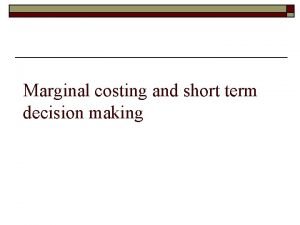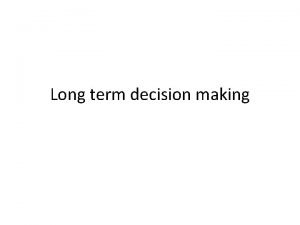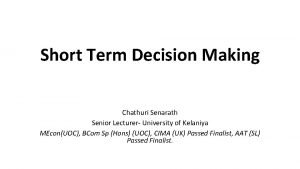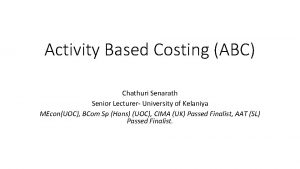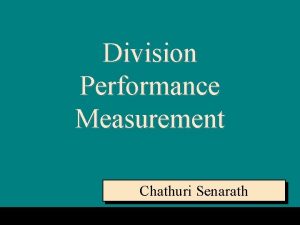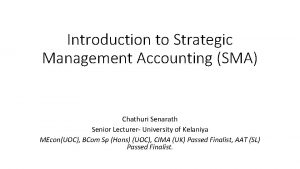Short Term Decision Making Chathuri Senarath Senior Lecturer


















- Slides: 18

Short Term Decision Making Chathuri Senarath Senior Lecturer- University of Kelaniya MEcon(UOC), BCom Sp (Hons) (UOC), CIMA (UK) Passed Finalist, AAT (SL) Passed Finalist.

Introduction • If any business is to be successful, it goes without saying that it is critical to make the right decisions. • While long‑term decisions are obviously important – by virtue of the fact that they often involve committing large sums of money to a project • The short‑term decisions are also pivotal to a company’s long‑term success. One could even argue that using the correct techniques to make short‑term decisions is even more important because, in management, short‑term decisions are made repeatedly in many different areas. For example, a business may have to decide whether to make components itself or buy them in; whether to accept or reject an order; whether to further process a product or sell it at its split‑off point; or how to best use resources when one or more of them becomes scarce.

Short term decisions have two characteristics that make them considerably simpler than longer term ones: • The time value of money can be ignored • Most fixed costs will be incurred anyway so can be ignored as not relevant In such cases the main approach is usually to consider relevant cash flows, which may simplify to looking at the impact of the decision on the total contribution.

Relevant cash flows for a decision. • Cash flows. To evaluate a decision, actual cash flows should be considered. Noncash items such as depreciation and inter divisional charges should be ignored. • Future costs and revenues. This means that past costs and revenues are only useful insofar as they provide a guide to the future. Costs already spent, known as sunk costs, are irrelevant for decision making. • Incremental costs and revenues. Only those costs and revenues that alter as a result of a decision are relevant. Where factors are common to all the alternatives being considered they can be ignored; only the differences are relevant. • Opportunity costs represent the costs of the opportunity that is lost, foregone or sacrificed by selecting one course of action instead of another. Opportunity costs only apply to the use of scarce resources. Where resources are not scarce there is no sacrifice in using these resources. Irrelevant costs and revenues are thus not specific to a particular decision; they do not differ between alternatives; and they may relate to the past.

Types of short term decisions • Short term output decisions • Product mix decisions where there is a capacity constraint • Special pricing decision • Make or buy decisions • Whether to replace equipment • Discontinuance decisions

1. Short term output decisions When considering output decisions (e. g. how many units to make and sell) in the short term, then decision making often focuses on contribution. Key decisions relate to the following: • How many units do we need to sell to break even? • What safety margin do we expect? • How many units need to be sold to achieve a target profit?

• Breakeven point (B. E. P. ) To calculate the number of units that must be made and sold in order to break even, we will use the following formula : Since the price per unit minus the variable costs of product is the definition of the contribution margin per unit, you can simply rephrase the equation by dividing the fixed costs by the contribution margin. Here, contribution per unit is calculated as Rs. 25 – Rs. 20 = Rs. 5 per unit; Breakeven point will therefore be Rs. 50, 000 / Rs. 5, or 10, 000 units.

• Breakeven Revenue The break-even point can be calculated again, but this time expressed in terms of sales revenue : The C/S ratio is normally expressed as a percentage. It is constant at all levels of activity. The C/S ratio reveals the amount of contribution that is earned for every $1 worth of sales revenue. The following formula is therefore used : For the example given C/S ratio can be calculated as Rs. 5/Rs. 25, or 20%. Therefore, For the company, this BEP in revenue will be calculated as Rs. 50, 000 / 0. 20 = Rs. 250, 000.

• Units required to achieve target profit To calculate the level of activity that is required to generate a profit of, say, Rs. 40, 000, we will use the following formula. Here, the number of units would be calculated as (Rs. 40, 000 + Rs. 50, 000 fixed costs) / Rs. 5 = 18, 000 units.

• The margin of safety is the difference between the budgeted level of activity, and the break-even level of activity. It may be expressed in terms of units, sales value or as a percentage of the original budget. Expected sales - Break-even sales Expected sales • Assume for example that the company budgets to sell 13, 000 units of Product PQ. Its margin of safety would be calculated as follows : • Margin of safety = 13, 000 - 10, 000 = 3, 000 units; • As a percentage of the budget, this is (3, 000 units / 13, 000 units) x 100 %, i. e. 23, 1%.

• Basic Breakeven Chart A basic breakeven chart records costs and revenues on the vertical axis (y) and the level of activity on the horizontal axis (x). Lines are drawn on the chart to represent costs and sales revenue. The breakeven point can be read off where the sales revenue line cuts the total cost line.

2. Product mix decisions where there is a capacity constraint These decisions arise where a business has, in the short term, limited or restricted capacity in some aspect of its production (e. g. machine hours). A decision must be made regarding which mix of products will utilize the limited capacity factor most effectively to maximize profits. • Single limiting factor decision making- Contribution per limiting factor • Multiple limiting factor decision making- Linear Programming

Single limiting factor decision-making • A limiting factor is any factor that is scare supply and that stops the organization from expanding its activities further. • There are various limiting factor situations; -Labor as a limiting factor -Material as a limiting factor -Machine hours as a limiting factor -Sales demand as a limiting factor It is assumed in limiting factor analysis that management would select a product mix or service mix that would maximise profit when contribution is maximized (given no change in fixed cost expenditure incurred). In other words, marginal costing ideas are applied.

• Contribution will be maximized by earning the biggest possible contribution per unit of limiting factor. For example if grade A labour is the limiting factor, contribution will be maximised by earning the biggest contribution per hour of grade A labour worked. • The limiting factor decision therefore involves the determination of the contribution earned per unit of limiting factor by each different product. • If the sales demand is limited; the profit-maximising decision will be to produce the top ranked product(s) up to the sales demand limit. • When there is just one limiting factor, the technique for establishing the contribution maximising product mix or service mix is to rank the products or services in order of contribution-earning ability per unit of limiting factor.

3. Special pricing decisions These usually involve ‘one off’ orders from customers that are not expected to recur and where a lower selling price may be offered. This type of decision arises where the business has spare production capacity and by fulfilling the special one off order it may boost its existing revenue and profits. For example, a t-shirt manufacturer may receive a one off order to produce 1, 000 t-shirts for a specific conference or other event. The main point here is that the pricing should be based on the relevant cost vs relevant revenue rather than for an accounting profit or loss.

4. Make or buy decisions This requires a company to consider the possibility of outsourcing some or all of its production. Outsourcing may enable the business to increase its profits by reducing its operating costs or by gaining access to greater production capacity. For example, a company manufacturing an existing product at a cost of € 0. 46 per unit might receive an offer from another supplier to produce and supply the product for € 0. 40 per unit. The company must then consider whether to continue to make the product in-house or outsource production to the supplier.

5. Whether to replace equipment • The business must consider the costs and benefits involved in replacing existing equipment with new equipment. For example, a business may be considering whether to try to improve efficiency by purchasing new production machinery and getting rid of the existing, old machinery

6. Discontinuance decisions The business must consider its current product/service/customer/location mix and the impact on its costs and revenues if a decision is taken to discontinue one or more of the existing products/services/customers/locations. For example, a company may be manufacturing four products but there may be very little profit arising from one particular product after all costs have been assigned and allocated. In this case the company must consider the implications on both total costs and total revenues of discontinuing the product.
 Short short short long long long short short short
Short short short long long long short short short Lecturer's name
Lecturer's name Marginal cost decision making
Marginal cost decision making No decision snap decision responsible decision
No decision snap decision responsible decision Slidetodoc.com
Slidetodoc.com Irr interpolation formula
Irr interpolation formula Short term decision
Short term decision Short medium and long term planning in education
Short medium and long term planning in education Long term memory vs short term memory
Long term memory vs short term memory Long term hr planning
Long term hr planning Difference between long term and short term liabilities
Difference between long term and short term liabilities Difference between long term and short term liabilities
Difference between long term and short term liabilities Long term goal
Long term goal Research paper on financial planning and forecasting
Research paper on financial planning and forecasting Physician associate lecturer
Physician associate lecturer Spe distinguished lecturer
Spe distinguished lecturer Teacher good morning class
Teacher good morning class Photography lecturer
Photography lecturer Lecturer in charge
Lecturer in charge


